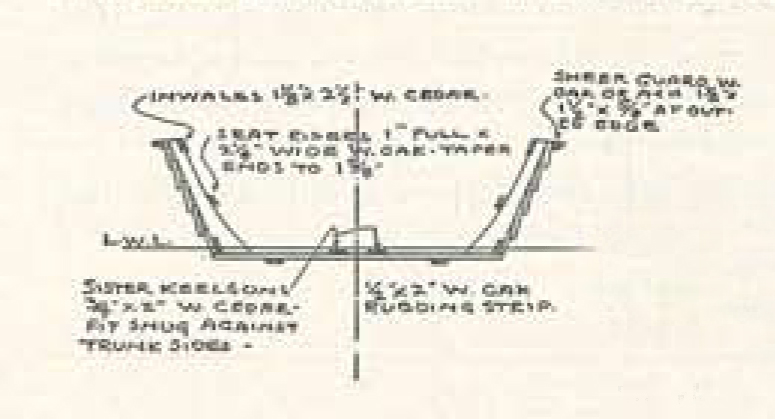This class has filled, but you can register for the waiting list.
Due to extremely high demand, we will have to limit the number of drop-ins, previously advertised as a $35/session option. Please email [email protected] at least 24 hours before the class to check on available space.
As if there was ever any doubt, traditional boatbuilding skills are as relevant as ever. Building a wooden boat without leaning upon the gap-filling qualities of epoxy or the strength of fiberglass is a great way to bolster your woodworking skills.
This winter, John Harris will lead a traditional boatbuilding class at CLC, meeting Wednesdays from 6pm until 8:30 or 9 or so. The course is designed to be enjoyable by everyone from rank beginners to seasoned boat carpenters.
We will be building a wooden lapstrake skiff from the 1930's and 1940's. Harris has chosen "Lark," a classic from the desk of William and John Atkin, prolific and masterful designers of small boats. The Atkins published wholesome, elegant, and enticing smallcraft, month after month, in magazines such as MotoR BoatinG and The Rudder.
"Lark" is perfectly proportioned, a 14-footer ideal for sailing, rowing, or powering with a small outboard.
In contrast to the computer-cut marine plywood boats most amateurs build today, "Lark" is built over a strongback, with stem, transom, frames, and stringers all planed to precise fits. The bottom is cross-planked and the sides comprise five copper-riveted strakes. We'll sharpen our planes---John will show you how---and assemble clear mahogany, cypress, and spruce into a versatile and beautiful craft. This is the sort of boat you'd have seen hard at work on Spa Creek in about 1935 or so.
This is not a "build your own" class; we'll concentrate on a single example, which will be raffled at the end of the series for the cost of materials.
CLC's classroom is heated, well-lit, and outfitted with every tool and convenience we could possibly need. (We won't hesitate to use power tools. They used bandsaws and so on in 1935, and this class isn't a time-travel stunt.)
The dates are:
- December 1st, 8th
- January 5th, 12th, 19th, 26th
- February 2nd, 9th, 16th, 23rd
Class starts at 6pm, and will continue until between 8:30 and 9.
There are no other costs and you do not need to bring any tools, unless you have your own small hand tools you'd prefer to use (or learn how to tune and sharpen).
Skills and components you'll encounter in this class:
- Visualizing three-dimensional hull shapes
- Strongback and mold assembly
- Traditional stem posts and splined transoms
- Rolling bevels and curving joinery
- "Lining off" planks
- Cutting "gains" with a rabbet plane
- Proper shaping of components such as thwarts and knees
- Elegant finish carpentry including bead wales, chamfering, etc.
- Spar building, if time allows
- Finish prep for traditional coatings
- Tool sharpening and care

To forestall the inevitable questions: there is NO possibility that the Atkins "Lark" design will become a CLC kit. Even if we owned the rights to the design, it's an intricate build using solid timber instead of plywood, and was chosen as an ideal subject for a traditional boatbuilding class.